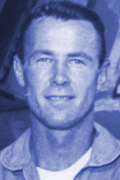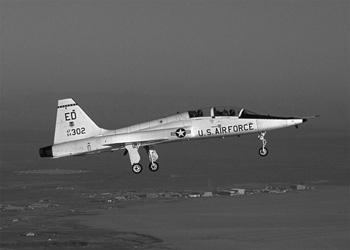Chapter 4 >
Autobiography home >
NF-104 home

|
Chapter 4 - Approach to Space click on the links below for more of the story... i. Test Pilots & Operations - ii. Experimental Testing - iii. F5-A Freedom Fighter - iv. Variable Dynamics - NF-101A - v. Anchors Aweigh - vi. Two Strakes - One Strike! - vii. Whirlybirds, Spinning Wings? - viii. The Rest of the Story |
||
Anchors AweighCarrier Qualification Plan
When I was at Eglin, a Navy test pilot in our organization, Lt. Commander Ted Smyer and his family were neighbors across the street. He gave me a great lesson on how to fly carrier landings in a Navy airplane, which he borrowed from Pensacola NAS, and we joined their training; flying with a Landing Officer wielding his “flags” for a couple of hours.
Ted taught me the most unique and critical skill, peculiar to carrier landing, which is reverse use of controls and power from the norm. In other words, when flying a carrier approach and landing, you control speed solely with the elevator (stick) and rate-of-descent entirely with power (throttle). Successful carrier approaches demand that airspeed be controlled within a knot for perfection, which can only be done by raising or lowering the nose to decrease and increase speed very precisely and quickly. Throttle power has to much time lag for precise speed control but is excellent to control a consistent approach angle when speed is perfect. Perfect speed and glide angle assure safe carrier landings. It took a bit of time to adjust to that and I continued to practice it every once in a while, throughout my flying days, as a sort of sport, hoping I might some day get my chance to really apply it.
Carriers had flags on deck to guide the pilot, when I learned with Ted, but “flags” were gone and the “mirror” with its meatball was in use, a real improvement, which made the approach much easier. So long as you are on speed, then keeping the meatball green with elevator movement is quite easy, but if speed varies it’s impossible. On local flights from Edwards, I began to fly over to Lemoore NAS near Bakersfield, whenever I had an opportunity with a T-38 jet trainer. I would call their tower and request Field Carrier Landing (FCL), touch-and-go, and they were very accommodating. It didn’t take long to get the feel.
The one thing I knew to avoid with an Air Force aircraft, since our landing gear would collapse under the force of impact in a carrier landing, or FCL, that was staying on a perfect glide slope down to landing, I would have to cheat. Over land, an airplane senses a cushion of air formed between the wings and ground, called ‘ground effect’, and that is readily noticed on the meatball by the need to suddenly push over to stay on slope, which is correct in a Navy aircraft. It was critical that I quickly pull the nose up as I hit ground effect in order to touch lightly on the ground, as I added full power to go around. In an actual carrier landing such a flare would be enough to miss the landing cables. With the advent of the canted flight deck such a miss would only mean a go-around not the inevitable crash into the barrier of WW II vintage carriers.
Soon I added the F-104A to my stable of aircraft for FCL’s and in spite of it’s higher landing approach speeds, it worked very well with fully blown flaps (blown: high speed engine gas is diverted over the top of the flaps to significantly increase lift).
As things worked out, the Northrup Corporation Director of Flight Test was a well-known Naval Aviator, who had been Captain of the carrier Independence. I got to know him testing their F-5 and mentioned my practicing FCL on the flags in Florida and my practicing at Lemoore, at which point he asked if I would like to do it in a Navy airplane. He arranged for me to go fly the A-4E, dubbed the Hot Rod, a beautiful little delta wing, with a stabilizer for good measure. I went to Lemoore and the Navy folks were so gracious. I got a cockpit briefing, cranked up and took off. That was such a nice flying machine that I was comfortable at the start, because it reminded me of my first solo jet flight in the F-80A. Not because of performance, which it had, but the very tight and small cockpit. I flew acrobatics first to get the feel and it was a great airplane, and very responsive. The remainder of the flight I spent making FCL’s. I did touch and go landings up till the last one to avoid taxi time, increasing opportunities for this grand experience. I didn’t know that I was being scored on every FCL and touch down to catch the correct wire, second arresting cable if my memory serves me, meant an ideal engagement on the carrier.
The C.O. met me at the airplane and complimented me on the landings for having hit the correct wire every time and an astounding thing happened, considering that I had no expectations other than that flight. The ‘Skipper’ said I would have to get 16 hours (as best I remember) of time in the airplane before he could arrange for me to take the A-4 aboard a carrier, and they would make the time available for me. I couldn’t believe it and never wanted anything more, but I was in the midst of the AeroSpace Trainer tests, and I was the only one permitted to fly our three aircraft. I could not be gone for an extended period, so took a rain check, thinking I would reach my goal, after a few months delay from my testing. Unfortunately, after Chuck Yeager crashed in an AST accident, I remained in that same quandary for over 15 months, with sole responsibility for flying the remaining two AST’s, whenever they were ready, and the long-running F-5 program, both of which persisted to a few days before I was transferred to Maryland.
A carrier landing was a flying dream that I came so close to fulfilling but missed. Even without any further flights in the A-4, I was absolutely comfortable to land aboard a carrier, and I really looked forward to the first night landing, which folks say is quite hairy, but both slipped away. My Uncle George would have been looking down on me or squeezed in next to me for that first carrier landing! Once earlier on, I had missed flying a P-38 by just one day, but losing that opportunity to fly like him was the most important “almost” in my flying career.
|
| previous section | next section |

